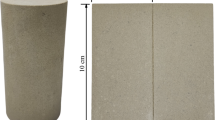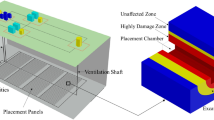Abstract
An experimental and numerical study was carried out to investigate matrix-fracture thermal transport in fractured rock. Two different synthetically fractured core plugs were used during the flow-through experiments while core plugs’ outer surface was maintained at two different constant temperatures. To investigate the matrix-fracture thermal transport, cold water was injected through the single fracture core plugs at different flow rates. A film type heat flux sensor was used in the fractured core plug to measure the fracture temperature and heat flux over the matrix-fracture interface. Experimental results showed that fracture temperature decreases with increasing flow rate while heat flux increases. At high flow rates, temperature difference over matrix-fracture interface increases due to large volume of water contacting the fracture at a given time. Water temperature decreased more in the case of fracture surrounded by rock matrix with low volumetric heat capacity and thermal conductivity. A numerical model calibrated using experimental values of the fracture temperature was developed to estimate thermal properties of rock matrix and to identify their importance on the matrix-fracture thermal transport. Using the calibrated numerical model, it has been shown that temperature in the fracture and fracture surface temperature are different contrary to previous studies assuming the same values for these two temperatures. Local and transient convective heat transfer coefficients were introduced with respect to local values of temperature difference and transient values of heat flux along matrix- fracture interface enabling accurate representation of matrix-fracture thermal transport.






















Similar content being viewed by others
Abbreviations
- \(\phi\) :
-
porosity [dimensionless]
- ρi :
-
density of component i [kg/m3]
- np :
-
total number of phase [dimensionless]
- cij :
-
fraction of component i in phase j [dimensionless]
- uj :
-
Darcy velocity of phase j [m/s]
- Ri :
-
total source/sink term for the component i [kg/m3·s]
- k:
-
intrinsic permeability [mD]
- krj :
-
relative permeability of phase j [dimensionless]
- μj :
-
viscosity of phase j [cp]
- pi :
-
is pressure of phase j [atm]
- γj :
-
specific weight of phase j [kg/m2·s2]
- d:
-
is vertical depth [m]
- ρR :
-
density of reservoir rock [kg/m3]
- Csp,R :
-
heat capacity of rock [J/K]
- ρj :
-
density of phase j [kg/m3]
- Csp,j :
-
heat capacity of phase j at constant volume [J/K]
- Cp,j :
-
heat capacity of phase j at constant pressure [J/K]
- κ:
-
thermal conductivity [J/m∙d∙K]
- Qgain :
-
heat gain rate [J/d]
- qH :
-
enthalpy source term [J/d]
- h:
-
Convective heat transfer coefficient (J/min cm2°C)
- q:
-
Heat flux (J/min cm2)
- Tf :
-
Temperature of flowing fluid in fracture (°C)
- Ts :
-
Temperature of solid surface (°C)
References
Abbasi M, Khazali N, Sharifi M (2017) Analytical model for convection-conduction heat transfer during water injection in fractured geothermal reservoirs with variable rock matrix block size. Geothermics 69:1–14
Bagalkot N, Kumar GS (2015) Thermal front propagation in variable aperture fracture–matrix system: A numerical study. Sadhana 40(2):605–622
Bagalkot N, Zare A, Kumar GS (2018) Influence of fracture heterogeneity using Linear Congruential Generator (LCG) on the thermal front propagation in a single geothermal fracture-rock matrix system. Energies 11(4):916
Berre I, Doster F, Keilegavlen E (2019) Flow in fractured porous media: a review of conceptual models and discretization approaches. Transp Porous Media 130:215–236. https://doi.org/10.1007/s11242-018-1171-6
Birhanu ZK, Kitterød NO, Krogstad H, Kværnø A (2017) Analytical and numerical solutions of radially symmetric aquifer thermal energy storage problems. Hydrol Earth Syst Sci Discuss 2017:1–19
Computer Modelling Group (CMG) (2017) STARS user guide. Computer Modelling Group Ltd, Calgary, pp 373–1531
Heiken G, Murphy H, Nunz G, Potter R, Grigsby C (1981) Hot dry rock geothermal energy: man-made systems now make it possible to extract heat from rocks in areas where natural fluids are insufficient for the development of hydrothermal energy. Am Sci 69(4):400–407
Heinze T, Hamidi S, Galvan B (2017) A dynamic heat transfer coefficient between fractured rock and flowing fluid. Geothermics 65:10–16
Kim K, Rutqvist J, Nakagawa S, Birkholzer J (2017) TOUGH–RBSN simulator for hydraulic fracture propagation within fractured media: Model validations against laboratory experiments. Comput Geosci 108:72–85. https://doi.org/10.1016/j.cageo.2017.05.011
Luo J, Zhu Y, Guo Q, Tan L, Zhuang Y, Liu M, Zhang C, Xiang W, Rohn J (2017) Experimental investigation of the hydraulic and heat-transfer properties of artificially fractured granite. Sci Rep 7:39882
Luo J, Qi Y, Zhao Q, Tan L, Xiang W, Rohn J (2018) Investigation of flow and heat transfer characteristics in fractured granite. Energies 11(5):1228
Martinez AR, Roubinet D, Tartakovsky D (2014) Analytical models of heat conduction in fractured rocks. J Geophys Res Solid Earth 119(1):83–98
Olasolo P, Juárez MC, Morales MP, D´Amico S, Liarte IA (2016) Enhanced geothermal systems (EGS): A review. Renew Sust Energy Rev 56:133–144
Shaik AR, Rahman SS, Tran NH, Tran T (2011) Numerical simulation of fluid-rock coupling heat transfer in naturally fractured geothermal system. Appl Therm Eng 31(10):1600–1606
Sibbitt WL, Dodson JG, Tester JW (1978) Thermal conductivity of rocks associated with energy extraction from hot dry rock geothermal systems. In: Mirkovich VV (ed) Thermal Conductivity 15. Springer US, Boston, pp 399–421
Yamaguchi S, Akibayashi S (1992) Heat transfer process in a hot dry geothermal reservoir 14th New Zealand Workshop. New Zealand, pp 133–138
Zhang G, Zhu J, Li J, Wang Q (2015) The analytical solution of the water-rock heat transfer coefficient and sensitivity analyses of parameters, Proceedings World Geothermal Congress, Melbourne, Australia
Zhao Z (2014) On the heat transfer coefficient between rock fracture walls and flowing fluid. Comput Geotech 59:105–111
Zhao J, Tso C (1993) Heat transfer by water flow in rock fractures and the application to hot dry rock geothermal systems. Int J Rock Mech Min Sci Geomech Abstr 30:633–641
Author information
Authors and Affiliations
Corresponding author
Additional information
Publisher’s note
Springer Nature remains neutral with regard to jurisdictional claims in published maps and institutional affiliations.
Rights and permissions
About this article
Cite this article
Tavakkoli Osgouei, Y., Akin, S. Experimental and numerical study of flow and thermal transport in fractured rock. Heat Mass Transfer 57, 1053–1068 (2021). https://doi.org/10.1007/s00231-020-03001-w
Received:
Accepted:
Published:
Issue Date:
DOI: https://doi.org/10.1007/s00231-020-03001-w




